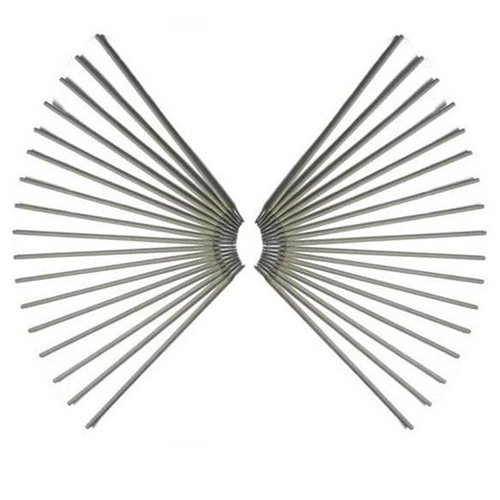CHARACTERISTICS & APPLICATIONS
ímet-9018B23(H4R) is low-hydrogen potassium iron powder type 2.5% Cr–1.5% W–0.2% Mo–0.20% V–0.04% Nb designed to provide improved creep strength, toughness, fatigue life, and oxidation and corrosion resistance at elevated temperatures. In addition to the classification requirements in this specification, impact toughness or high temperature creep strength properties may be determined. Additional testing requirements, if desired by the customer, can also be met with depending upon the application. They are designed to produce weld metal for high-temperature service and for matching the properties of the typical base metals such as A29 Grade 1015 or 1020, A283 Grade A, B, C, or D, A36, A131 Grade B UNS Nr G10150, G10200, K01400, K01702, K02401, K02801, K02702, K02600 K02102.
Since all Cr-Mo electrodes produce weld metal which will harden in still air, both preheat and PWHT are required for most applications. No minimum notch toughness requirements have been established for any of the Cr-Mo electrode classifications. While it is possible to obtain Cr-Mo electrodes with minimum toughness values at ambient temperatures down to 0°C, specific values and testing may be agreed, if desired based on job requirements.
Storage and Drying Conditions: Not recommended | Ambient temperature (For R-Class)
Hydrogen can have adverse effects on welds in some steels under certain conditions. One source of this hydrogen is moisture in the electrode coverings. For this reason, the proper storage, treatment, and handling of electrodes are necessary.
Holding Ovens: 125°C–150°C Drying Conditions: 250°C–425°C
CHEMICAL COMPOSITION OF UNDILUTED WELD
| C | Mn | Si | P | S | Ni | Cr | Mo | W | V | Nb | B | Al | Cu |
N |
|
0.04-0.12 |
1.00 | 0.60 | 0.015 | 0.015 | 0.50 | 1.90-2.90 | 0.30 | 1.50-2.00 | 0.15-0.30 | 0.02-0.10 | 0.006 | 0.04 | 0.25 | 0.05 |
Single values are maxima, except where specified otherwise.
ALL-WELD-METAL MECHANICAL PROPERTIES
Preheat and Interpass :180-250°C | Post weld Heat Treatment : 740±15°C for 2 Hour(s) The temperature shall be raised at the rate of 85°C to 280°C per hour and allowed to cool at a rate not greater than 200°C per hour, and may be removed from the furnace when the temperature of the furnace has reached 300°C and allowed to cool in still air.
|
Tensile Strength, MPa |
Yield Strength, At 0.2% Offset, MPa | Elongation % |
Charpy V-Notch Impact at NS°C, Joules |
|
620 |
530 | 17 |
NS |
Single values are minimal.
Limit of Moisture Content, % by weight max: 0.15 max (Reconditioned) | NS (As Exposed) for H4 version Diffusible Hydrogen Content Average, Maximum, mL(H2)/100 g Deposited Metal: 4.00
Welding Considerations
Preheat and interpass minimum temperatures also have a significant effect on the strength levels attained with certain low-alloy steel weld metals. These weld metals are affected by rapid cooling rates which tend to produce more martensitic or bainitic microstructures. These microstructures will often exhibit higher yield and tensile strengths with a decrease in ductility.
The cooling rate can be retarded by utilizing a higher preheat and interpass temperature. The preheat and interpass temperature ranges given herein are adequate for the preparation of the test assemblies.
However, in actual production, users are encouraged to test their own procedures to verify that they have selected preheat and interpass temperatures which will produce desirable results in production.
Due to the thick covering and deep cup produced at the arcing end of the electrode, iron powder electrodes can be used very effectively with a “drag” technique. This technique consists of keeping the electrode covering in contact with the work piece at all times, which makes for easy handling. However, a technique using a short arc length is preferable if the 2.5 mm or 3.2 mm electrodes are to be used in other than flat or horizontal fillet welding positions or for making groove welds.
SIZES & CURRENT CONDITIONS (AC or DCEP)
|
DIAMETER, mm |
LENGTH, mm |
Amperes |
|
2.50 |
350 | 70-100 |
| 3.15, 3.20 | 350 |
115-155 |
|
4.00 |
350, 450 | 135-185 |
| 5.00 | 450 |
200-275 |
NOTE: H4 R variant is available for supply on request.
WARNING: Safety and health information is available from many sources, including, but not limited to Safety and Health Fact Sheets listed in A11.3, ANSI Z49.1 Safety in Welding, Cutting, and Allied Processes published by the American Welding Society, 8669 Doral Blvd., Suite 130, Doral, FL 33166., and applicable federal and state regulations. The Safety and Health Fact Sheets are revised, and additional sheets added periodically.

